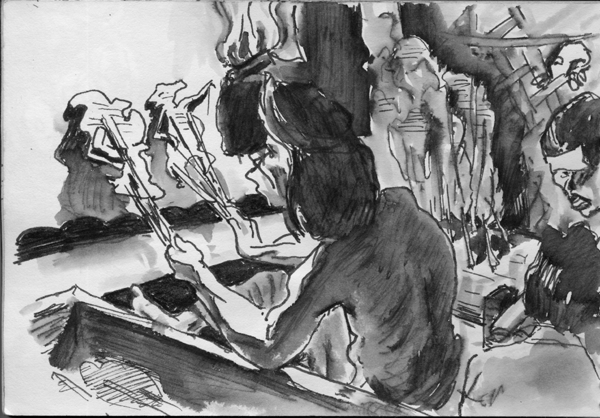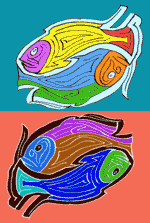|
Shadow play
In Indonesia I had sketchbooks so small that I could carry them in a shirt pocket. Standing amid the crowds whose heads were below my shoulders, I could lift the sketchbook from my pocket and, close under my chin and above the Indonesian heads and shoulders (sometimes using them for support), sketch Indonesia's teeming scenes, though I despaired of drawing enough of the chocolaty Malay faces. They couldn't overlook me (though sometimes I did sit on the ground to draw, overlooked by crowds of children). In this way I filled, mostly on both sides of the paper, four of these sketchbooks (besides parts of some larger ones).
The crudest and least intelligible sketch was the one I felt proudest of achieving in the circumstances. It was at Ubud during a wayang kulit or shadow puppet play, a performance, as in the many other kinds of drama, of some of the familiar stories from the immense Hindu epic, the Mahabharata. The dalang and the four members of the gamelan orchestra backing him (two of whose heads can be seen behind him) are crammed inside a small square kiosk made of basketry. You can see, in the far wall, a rent with a face peering through. I am peering through just such a crevice in the near wall, jostling with other peerers as I strive desperately to sketch. “He comes from Sanur,” one of them tells me. He is shirtless in the torrid heat, while a brazier of thick flames hangs roaring at his brow and casts on the translucent screen, to be seen by the crowd in the night outside, the jittering shadows — with scarcely a trace of the colors — of the puppets he brandishes. The puppets, carved from buffalo parchment, have moving limbs operated by strings, and he sometimes manipulates two with each hand. He chants with a different voice for each character — raucous for the demons, dulcet for the heroines — occasionally spitting and taking a drink of water from an assistant. To his right can be seen a forest of other puppets planted by their sticks in a soft green banana log; there are others — scores or hundreds altogether — for him to snatch as he needs them, to his left in another log (out of sight — too near) and in a coffin-like box. On this box he bangs for emphasis, with a wooden cone in his left hand if that happens to be free, otherwise with a sandal (omitted) on his right foot.

After the first hour, there was a shower and the audience took partial refuge, but not far away: I could hear them still laughing at the topical jokes the dalang built into his variants of the traditional words. Laughter again as someone in the darkness fell into a pool. And frogs, some of them inside the straw of the kiosk's roof, accompanied singer and orchestra, to strange effect. The living story, with its battles and clowns and seductions and transformations, kept on till dawn, but as I fled across the street to Ary's café to water-and-brush the shadows of my drawing while I remembered them, drops of rain spoiled critical places, such as the bridge of the dalang's nose. I realize now that the wild hawkish face can be misinterpreted. The longest prominence is his upper lip. If you take it as the nose, it is some other kind of face.
To such accidents is a half-controlled pen prone. And the sketch needs all this explaining and excusing. Yet such a scene could not have been recorded by photography, without a flash, which besides offending against the performers would have destroyed the shadows within and without.
BACK
|


